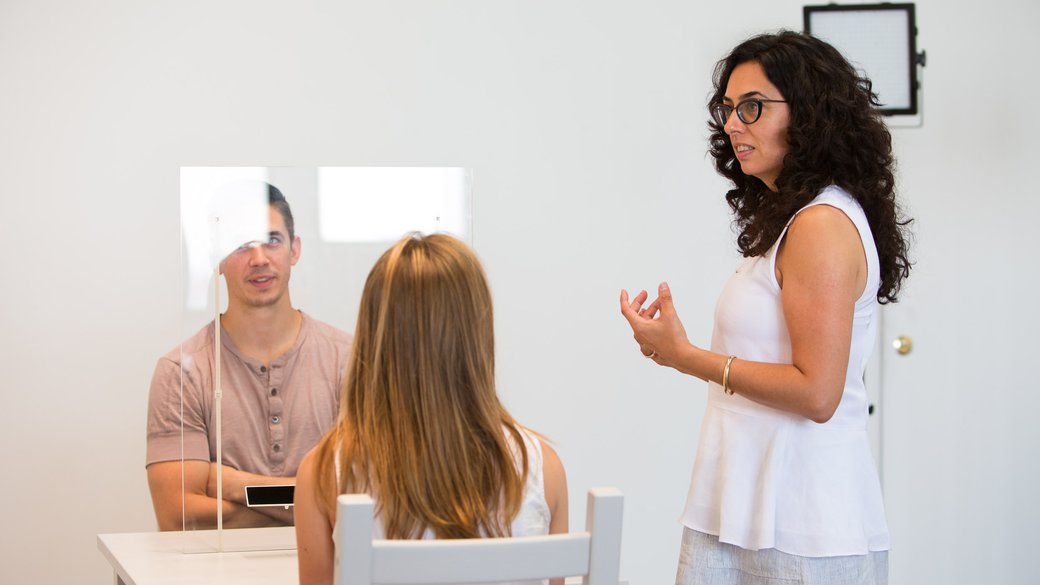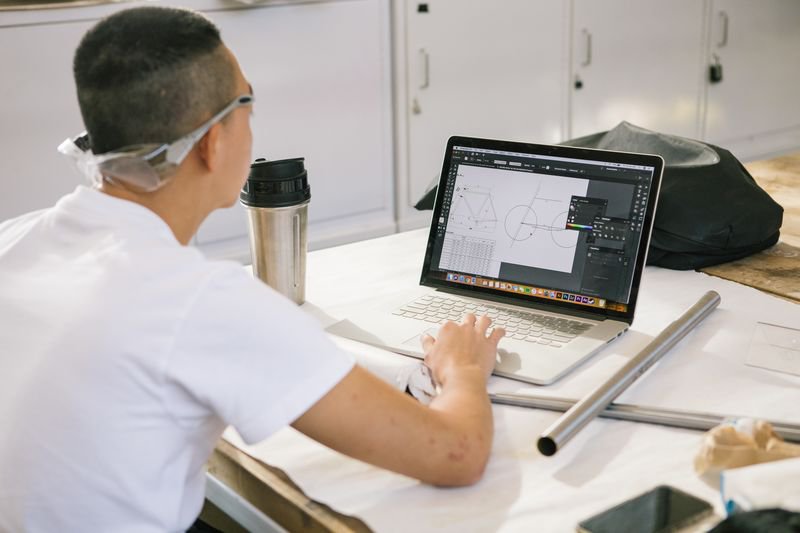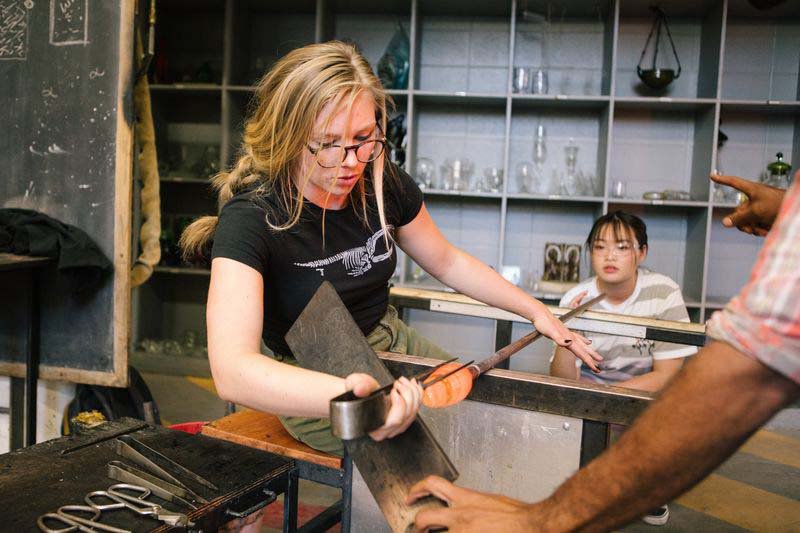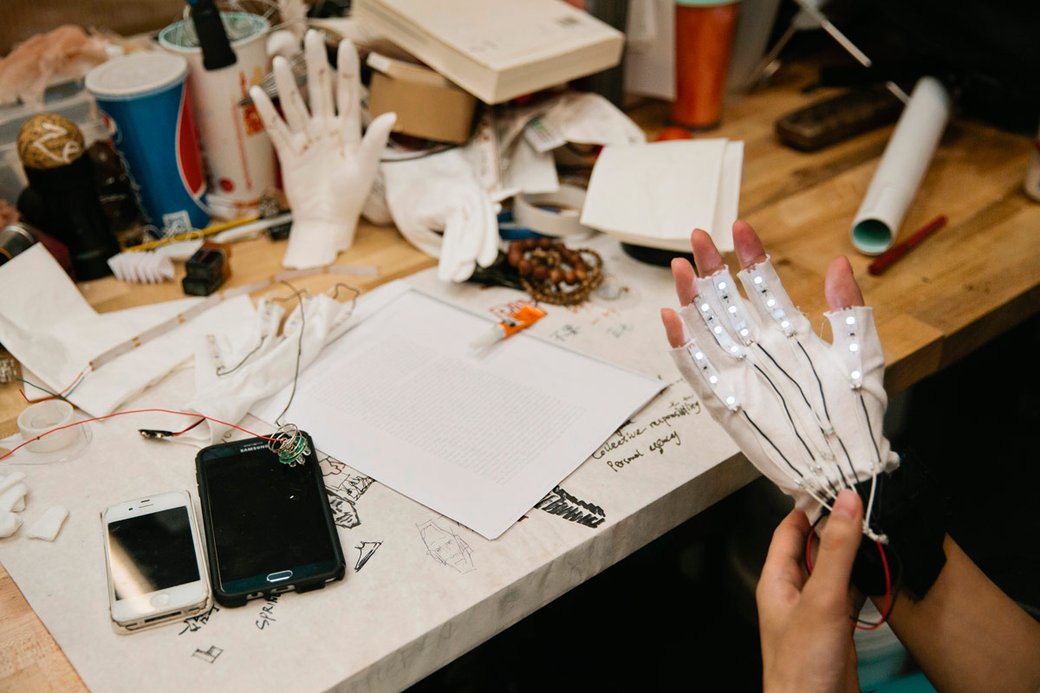
The interdisciplinary future of design: Interview with Dean Helen Maria Nugent
Our dean talks about growing an expansive mindset, defining informed intuition, and more.
Q + A: Dean of Design Helen Maria Nugent

Helen Maria Nugent, Manifesting Looks of Love
From Scotland to SAIC to CCA
CCA Dean of Design Helen Maria Nugent grew up in Scotland in a family of coal miners and nurses. She was the first in her family to go to college. “Design wasn’t something we talked about or looked at every day. I didn’t know any designers. It just wasn’t part of my vocabulary,” Nugent remembers. But she liked making art.
After high school, Nugent decided to go to art school at the renowned Glasgow School of Art, a school she likens to CCA, especially for its deep-rooted Arts and Crafts tradition. Once there, she entered a BFA program in Environmental Art, which offered a broad exploration of public art, involving installations ranging from the micro to the highly complex. A career in design still wasn’t in the plans, that is, until a faculty member surprised her, observing that her projects were highly design-oriented.
“I would develop proposals, make visualizations, talk to stakeholders, get buy-in, write grants for funding, work with fabricators, solicit feedback,” Nugent says, “still not realizing I was doing design. But I was. I was doing very design-driven public art.” With encouragement from the faculty, Nugent decided to pursue a graduate degree in design.
That was a decisive move, and from there, Nugent carved a deliberate path that took her to the School of the Art Institute of Chicago (SAIC) where she taught and served as chair of the Designed Objects programs; director of its MDes, MFA, and BFA Pathway programs; and director of its First-Year program. She’s the co-founder of HAELO Design with Ron Kirkpatrick. HAELO is an independent, research-oriented studio that pursues speculative and commercial design projects with a focus on furniture, objects, services, and exhibition design.
Nugent was appointed dean of Design at CCA in June 2017. We sat down to talk with her about some of the intangible skills gained in a design education and her excitement about CCA’s expansion.
“There’s actually a way of understanding the world that designers are trained in that is now necessary in almost every occasion.”

When students go through CCA’s design programs, either as undergraduates or graduates, they’re gaining a wide array of specific technical skills, but they’re also being trained in a specific way of thinking and problem-solving. Can you speak to that?
I think visual literacy is a critical piece of a design education. Designers are visually literate in the world, some more in two-dimensional materials and some in three. I think the literacy of art school is that everyone walks out the door and is able to see things other people may not pay attention to. They’re able to see why things work, why they make sense. They’re able to analyze how a visual image may have come together because they’ve put together something very similar in the past. They’ve practiced, adding new data and new information to an intuitive understanding of how something works. So their ability to create visual culture means that they’re also able to analyze and synthesize.
In order to make anything, you have to know what you’re making it. I've been talking a lot lately with faculty about this idea of the designerly way of knowing. There's actually a way of understanding the world that designers are trained in that is now necessary in almost every occasion. Designers are constantly problem-solving. They have to have the ability to analyze and synthesize very disparate kinds of information in order to make decisions. That thinking process is done in architecture, the arts, and all sorts of fields. But in design, it’s the background to what designers are doing in terms of their craft.
How does that thought process intersect with the practice of craft?
We’re teaching students an incredibly deep set of craft skills here, but because of the nature of the school and of the faculty teaching here, there’s never a separation between craft and idea. They’re always joined together. So even if a student is in a class that’s focused on an aligned way of learning a 3D modeling software, for example, they’re not just learning the software, they’re also doing a design problem. They’re questioning how much the software is pushing the solution and how much they’re pushing the software. The realization is that at a certain point, every tool dictates how you work, and you have to be super conscious about that. Sometimes it makes sense to recognize the limits of the software and go back to a sketch.
Design students are making, drawing, using technology, and learning all kinds of contemporary tools and materials, but they’re also doing something highly analytical. Designers are really well trained to deal with ambiguity. At the start of a design problem, there isn’t an answer. It’s your job to figure out what the right answer is. So how do you do that? It’s a process. Am I going to talk with people? Am I going to look at precedence? How do I find a way to start my thinking? Designers do this very naturally, and at CCA we train them to do it. Ambiguity is a difficult thing to deal with now. That’s where we’re at in the world. We don’t know what’s going to happen next. We don’t know where technology is taking us. Designers have informed intuition about where we’re going and how we can participate in those changes. That’s where the artistry is in design, and it involves a very analytical skill set.

What do you mean by informed intuition?
Informed intuition is what I always talk about. By doing, by learning how to make, by practicing—which is what you do in school—you have an intuitive sense of how to put something together. But that’s not very useful unless it’s informed by actual information, actual data. The old idea of, “It’s just going to come out of my head,” is not real. The reason it comes out of your head is because you’ve studied that a lot, and you’ve talked to people about it a lot, and you’ve done a problem that’s similar to that. You actually have some crucial information that you’re applying to that intuition.
Let’s dive more into that, because the informed intuition that comes from making is intrinsically linked to craft, which continues to be at the core of a CCA education. Why is the practice of craft fundamental?
Jony Ive (Apple’s head designer) did this interview a few years ago with the online design magazine Dezeen. It’s brilliant. He talks about what he describes as a real problem in education and the issue that he couldn’t hire any designers because designers were lacking the skills he needed. I’ve pulled it up. He says, “So many of the designers we interview don’t know how to make stuff because workshops in design schools are expensive and computers are cheap. And that’s just tragic, because you can spend four years of your life studying design of three dimensions and not make anything.”
What he means is that many design schools make stuff, but they don’t have access to materials that go beyond prototyping. The whole set of materials are in the art. Artists don’t make projects, they make real things on a daily basis. He says that “Why?” should be the designer’s first reaction. He gives the example of a glass cup and says that rather than first trying to understand glass and everything you can do with glass, you should go make an alias rendering of a glass cup. When I read that, I said, “Yes!” That really resonated. That’s what we’re doing here.
How does that tie into CCA’s expansion? Does it fuel the kind of education and training Ives describes a need for?
One of the really unique things that’s happening is that with the unified campus, the school has chosen to bring all of the traditional heavy industry crafts here to San Francisco. That’s a huge move—to bring a hot shop for glass, to bring a foundry here—and it’s a huge investment. We’re basically putting this heavy industry in the middle of the tech industry. Our students are really into design, and one of the reasons they come here is because of course they want to be designers, but they’re also makers. They really want to make things. So to go back to the glass example, they have the opportunity not to just simply imagine a glass object or make a rendering of a glass object, but to actually make a glass object is incredibly thrilling.
So it’s not like they’re going to be crafters of glass the way the glass majors would be, but they will know how complex it is to shape glass. They’ll have a sense of its materiality and of what is possible and what’s not possible. That just makes their minds as designers work really differently.
The proximity of these kinds of traditional materials and methods is a unique proposition, regardless of whether a student is literally taking three glass classes or simply getting to know a glass student and spending time in the shop. The more and more students have to deal with technology, the more important it is that they have this way of understanding materiality, and I think that’s going to be a really amazing future for us.
We’re already thinking about new ways of thinking about the facilities, and of putting in place intersections between different kinds of artists and designers so that new things can happen, about creating a kind of spark. We’re creating a space where students can literally come together and then cross over with other technologies and gain from the skills that come from that earning. And hopefully that will be very inspiring.

We talk a lot about the interdisciplinary curriculum at CCA. Where do you see it happening within design?
In order to be interdisciplinary, you have to have a discipline. So my way of thinking about it is that things are interdisciplinary when you’re bringing together people with disciplinary expertise to work on something together. The results of that are interdisciplinary.
All of our students have interdisciplinary skills, but their interest is in a particular discipline of expertise. That’s what’s interesting to me. I don’t think we are doing interdisciplinary design. I think we're doing graphic design and thinking about it in a really expansive way, and I think we’re doing interaction design and thinking about it in a really expansive way. We’re in the center and on the edge of all of these traditional disciplines.
There are a lot of skills that designers need to have now. Visual designers, graphic designers, and interaction designers are all are working on the visual end. They have to have great graphic design skills, but also great 3D skills. The skill set of a designer is expanding with categories of design blending into each other because we are designing things which are multifaceted. And there are constantly spaces between the edges of defined disciplines where new stuff happens. Last year we ran a really interesting sponsored studio with Ford and they said, “We’re doing a project. We think we probably need some graphic design skills. We probably need some product designers, and we probably need some interaction designers. Can you do that?”
We were able to pull together a class of students, mostly product designers, but also some MFA Design students and some interaction design students. The project was completely interdisciplinary, meaning they were designing public spaces, products, interactive spaces, systems and services, and small objects that were portable, wearable objects. The students designed everything from soup to nuts that could be connected with mobility, except for the car. This was exactly what Ford wanted, because of the future of the way that we will be using small cars.
For me, that’s really exciting, because that means we’re actually sending people out into the world who can say, “Yeah, I’m a graphic designer, but I’m really focused in digital and interactive space.” That is awesome.
Learn more about CCA’s design programs and attend an event.
Discover our range of creative practices


